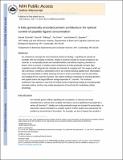A fully genetically encoded protein architecture for optical control of peptide ligand concentration
Author(s)
Schmidt, Daniel; Tillberg, Paul W.; Chen, Fei; Boyden, Edward
DownloadBoyden_A fully.pdf (1.067Mb)
PUBLISHER_POLICY
Publisher Policy
Article is made available in accordance with the publisher's policy and may be subject to US copyright law. Please refer to the publisher's site for terms of use.
Terms of use
Metadata
Show full item recordAbstract
Ion channels are among the most important proteins in biology, regulating the activity of excitable cells and changing in diseases. Ideally it would be possible to actuate endogenous ion channels, in a temporally precise and reversible manner, and without requiring chemical cofactors. Here we present a modular protein architecture for fully genetically encoded, light-modulated control of ligands that modulate ion channels of a targeted cell. Our reagent, which we call a lumitoxin, combines a photoswitch and an ion channel-blocking peptide toxin. Illumination causes the photoswitch to unfold, lowering the toxin’s local concentration near the cell surface, and enabling the ion channel to function. We explore lumitoxin modularity by showing operation with peptide toxins that target different voltage-dependent K+ channels. The lumitoxin architecture may represent a new kind of modular protein-engineering strategy for designing light-activated proteins, and thus may enable development of novel tools for modulating cellular physiology.
Date issued
2014-01Department
Massachusetts Institute of Technology. Materials Processing Center; Massachusetts Institute of Technology. Department of Brain and Cognitive Sciences; Massachusetts Institute of Technology. Department of Electrical Engineering and Computer Science; McGovern Institute for Brain Research at MIT; Program in Media Arts and Sciences (Massachusetts Institute of Technology)Journal
Nature Communications
Publisher
Nature Publishing Group
Citation
Schmidt, Daniel, Paul W. Tillberg, Fei Chen, and Edward S. Boyden. “A Fully Genetically Encoded Protein Architecture for Optical Control of Peptide Ligand Concentration.” Nature Communications 5 (January 10, 2014).
Version: Author's final manuscript
ISSN
2041-1723